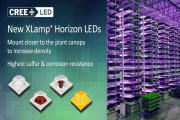A more efficient, safer and longer-lasting light bulb technology is emerging and starting to appear on store shelves, it is called LED.
The first high-profile breakout from traditional LED applications appeared in Christmas lights in 2002. Nowadays an entire string of colourful LED holiday lights uses less energy than did a single old incandescent holiday bulb. The working life of LED lights is measured in tens of thousands of hours, not just thousands. So, how long before LED bulbs become available for serious, interior lighting applications in lamps and overhead fixtures?
LED bulbs are particularly efficient and long-lasting because they produce light in an entirely different way from other kinds of bulbs. Instead of using electricity to heat up a metal filament or excite a conductive gas, LEDs produce light by channelling electric current through a semiconductor. In the most efficient examples, this approach converts almost 100 per cent of the electricity into light, with virtually no waste heat produced.
It's now possible to buy LED equivalents for retrofitting various types of household and specialty light fixtures that were originally designed for incandescent bulbs. The price of an MR16 LED to replace traditional halogen designs runs from $35 to $60 for a single bulb. That's about five to eight times more money than a regular halogen bulb, but the LED lasts 20 to 25 times longer while using 90 per cent less energy.
That's why LEDs make especially good sense in applications where lights stay on a lot, where the heat buildup of traditional bulbs is a problem, or where it's difficult to change bulbs after they burn out. These include commercial and high-rise residential applications, where lights are burning 24/7. They're also useful for exterior residential applications, especially when changing a bulb involves climbing up a ladder. LEDs last for years and function well where it's cold. They don't emit UV rays, either, so they won't cause fading of fabrics and surfaces.
LED lighting is a response to the disappearance of the cheap, convenient and plentiful sources of energy we've relied on. As prices drop, LEDs redesigned for more applications.





 CN
TW
EN
CN
TW
EN





